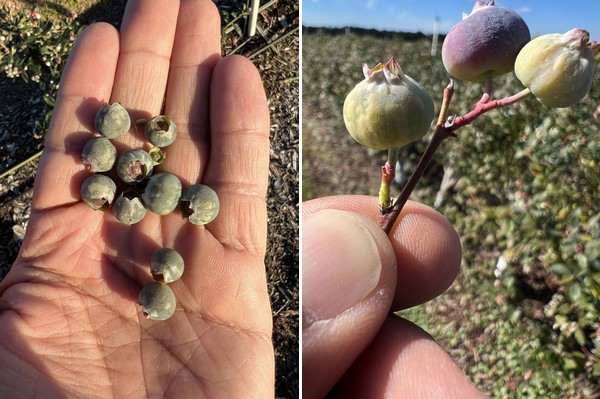Following the cold temperatures that hit Florida the first weekend in February, Florida’s blueberry growers are still assessing how well their crops made it through.
“Florida growers experienced significant cold temperatures several nights in a row--most growers are reporting minimal damage. But in some instances, the weight of the ice did cause breakage,” says Brittany Lee of the Florida Blueberry Growers Association based in Gainesville, FL. “We do not expect this to impact our state production and look forward to a solid year.”
The concern for Florida’s blueberries was tied to the cold snap that was part of the winter storm on the U.S. East Coast the first weekend of the month. “Temperatures were very cold early Sunday and Monday mornings, reaching as low as the mid-20s F on Sunday morning in some Florida locations,” said Patricio Munoz, UF/IFAS blueberry breeder and associate professor.
 Photo: University of Florida
Photo: University of Florida
How cold is too cold?
That said, experience gives Florida growers the knowledge that green fruit and blueberry flowers can survive temperatures as low as 26 F. “However it depends on other weather conditions including wind and dew point,” says Munoz. “Blueberry floral tissues are most sensitive to cold damage at the full bloom stage, with young green fruit only somewhat less sensitive.”
Due to very warm temperatures that took place in December, many farms throughout Florida did have flowers and fruit at those very stages. That made freeze protection important to maintain fruit production.
Munoz said that almost all blueberry growers in Florida used freeze protection, largely through overhead water irrigation systems. “Overhead irrigation warms the fields with well water that is warmer than the air temperatures which forms a protective layer of ice on the plants,” says Munoz. “When water changes from a liquid to a solid form it releases a certain amount of heat, and good, uniform ice coverage helps keep the plant tissues from dropping below damaging temperatures.”
Minor damage seen to date
However, this type of freeze protection could also cause damage if it’s not executed properly or the freeze is too extensive and the weight from the ice damages the branches or plants. “Many growers reported only minor observable damage by early last week, with most damage taking the form of broken branches/canes or plants lying on the ground due to the weight of ice,” says Munoz. “As expected, a few growers reported some freeze damage at the perimeter of their fields, or in areas where it is difficult to achieve good water protection.”
And where to next? Munoz says it will check in with growers late this week or early next week to see if there indeed was any damage to fruit or flowers--this can appear up to several days after a freeze. “Damage would present as a discoloration on the outside of the fruit, brown flower petals, and brown to black areas on the inside of the floral buds or berries,” says Munoz.
That said, it can be difficult to fully assess the actual levels of damage and Munoz says it’s expected damage will vary from farm to farm across the state.
 For more information:
For more information:
Brittany Lee
Florida Blueberry Growers Association
Tel: +1 (352) 448-1418
[email protected]
https://www.floridablueberrygrowers.org/
 Brad Buck
Brad Buck
University of Florida
Tel: +1 (813) 757-2224
[email protected]
www.ifas.ufl.edu
